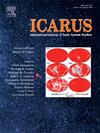丢失的柯伊伯带双星在哪里?
IF 3
2区 物理与天体物理
Q2 ASTRONOMY & ASTROPHYSICS
引用次数: 0
摘要
在这封书信中,我们提请注意柯伊伯带中质量在≈1019−1020 kg之间的双星间隙,对应的是4到5绝对星等h之间的双星的缺失。该间隙的低质量端与OSSOS调查提出的400 km处冷经典种群的截断一致,并通过流不稳定性模拟星子形成预测。所有柯伊伯带天体的星等分布都是连续的,这意味着许多天体存在于间隙中,但这个范围内的双星要么被打乱了,要么伴星离主星太近,或者太暗,无法用当前的观测仪器探测到。在间隙的高质量一侧,物体在小间距处有小卫星,并且我们发现随着质量的减小,初级半径与次级半长半径的比值增加。如果这种趋势继续下去,非开普勒效应应该会使质量测定更具挑战性。本文章由计算机程序翻译,如有差异,请以英文原文为准。
Where are the missing Kuiper Belt binaries?
In this letter, we call attention to a gap in binaries in the Kuiper belt in the mass range between 1019−1020 kg, with a corresponding dearth in binaries between 4th and 5th absolute magnitude . The low-mass end of the gap is consistent with the truncation of the cold classical population at 400 km, as suggested by the OSSOS survey, and predicted by simulations of planetesimal formation by streaming instability. The distribution of magnitudes for all KBOs is continuous, which means that many objects exist in the gap, but the binaries in this range have either been disrupted, or the companions are too close to the primary and/or too dim to be detected with the current generation of observational instruments. At the high-mass side of the gap, the objects have small satellites at small separations, and we find a trend that as mass decreases, the ratio of primary radius to secondary semimajor increases. If this trend continues into the gap, non-Keplerian effects should make mass determination more challenging.
求助全文
通过发布文献求助,成功后即可免费获取论文全文。
去求助
来源期刊

Icarus
地学天文-天文与天体物理
CiteScore
6.30
自引率
18.80%
发文量
356
审稿时长
2-4 weeks
期刊介绍:
Icarus is devoted to the publication of original contributions in the field of Solar System studies. Manuscripts reporting the results of new research - observational, experimental, or theoretical - concerning the astronomy, geology, meteorology, physics, chemistry, biology, and other scientific aspects of our Solar System or extrasolar systems are welcome. The journal generally does not publish papers devoted exclusively to the Sun, the Earth, celestial mechanics, meteoritics, or astrophysics. Icarus does not publish papers that provide "improved" versions of Bode''s law, or other numerical relations, without a sound physical basis. Icarus does not publish meeting announcements or general notices. Reviews, historical papers, and manuscripts describing spacecraft instrumentation may be considered, but only with prior approval of the editor. An entire issue of the journal is occasionally devoted to a single subject, usually arising from a conference on the same topic. The language of publication is English. American or British usage is accepted, but not a mixture of these.
 求助内容:
求助内容: 应助结果提醒方式:
应助结果提醒方式:


